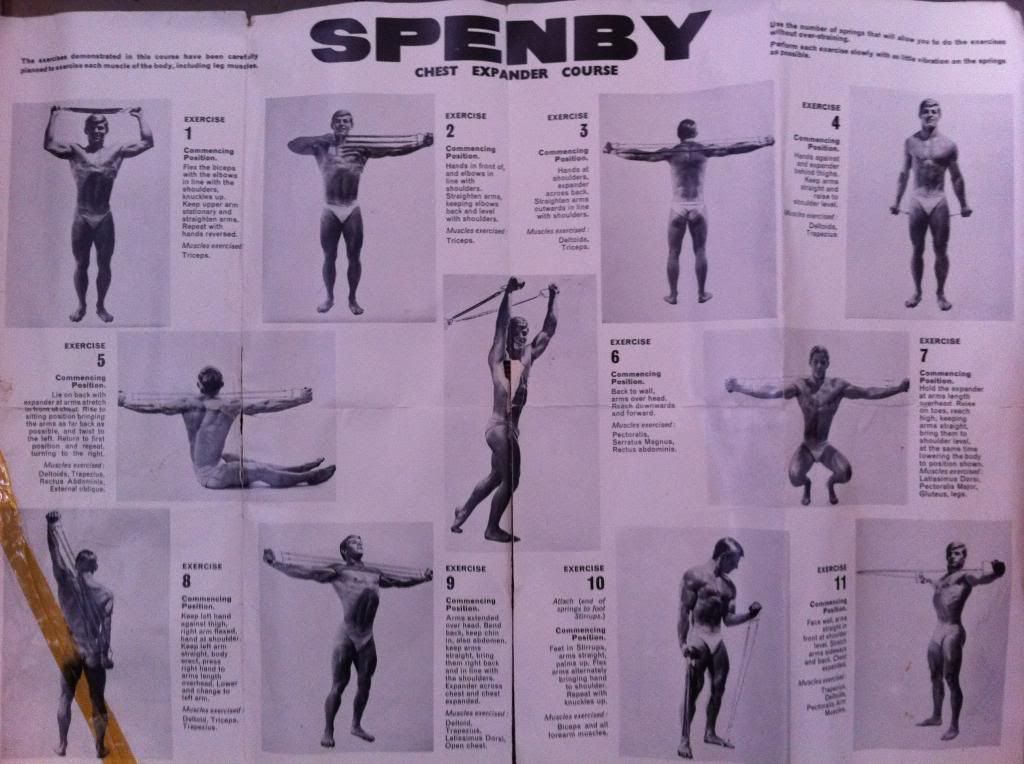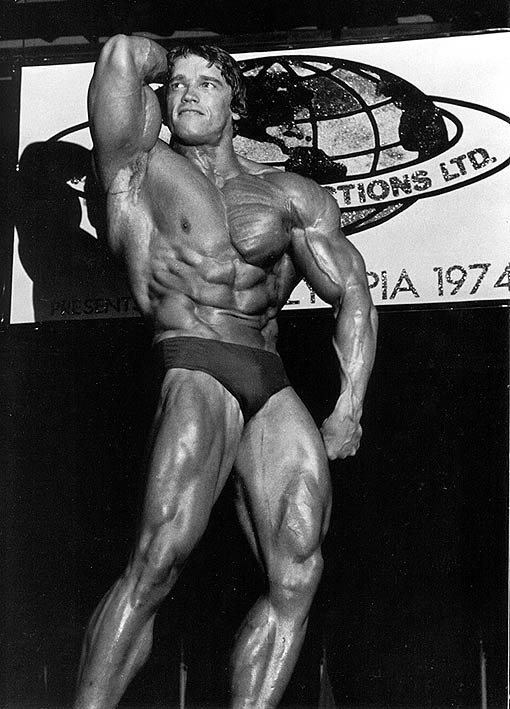Don Ross
Click Pics to ENLARGE
Lou Ferrigno
A GUIDE TO CHAMPIONSHIP SHOULDERS
by
Don Ross (1973)
A GUIDE TO CHAMPIONSHIP SHOULDERS
by
Don Ross (1973)
Big shoulders are indicative of a powerful man, even more so than arm development. When a weightlifting champion, pro wrestler, of heavyweight boxing champion is seen wearing a coat or sport jacket, it is the width of his shoulders that makes him stand out in a crowd. Record bench presses and Olympic lifts are largely the result of superior shoulder strength.
Those who begin bodybuilding with wide shoulders are very fortunate. Bone structure largely determines a person's shoulder girth. Those with wide scapula (shoulder blades) can more easily achieve that tapered look that is very much emphasized in modern physique competition. If you re not blessed with wide shoulders, you have special work to do to make up for this and your shoulder routine will be different from that of a broader person.
A) Training for Width
When I began bodybuilding, my shoulders were considerably under par. It seemed as though my hips were wider than my shoulders. I did not let this discourage me and, in fact, worked my shoulders more than any other body part in many of my workouts. Shoulder work cannot be over-emphasized. I have yet to see a pair of overdeveloped shoulders.
To begin with, shoulder width by skeletal structure can be broadened somewhat. This can be done by stretching the ligaments of the scapula. The best way to do this is with wide grip chin-ups. Spacing your hands far apart on the bar, do two sets of as many chin-ups as possible. If you have wrist straps available, use them to help you hang onto the bar. After each set, when you are no longer able to perform any more reps, let yourself hang for a minute or so.
The next two exercises in this routine are for enlarging the outer head of the deltoid muscles. This will complete the wide look by thickening the shoulder muscles themselves. Using a collar-to-collar grip on a standard barbell, do four sets of presses behind the neck. Bring the bar all the way down to the base of the neck, then lock out overhead. Do between 6-8 reps. Use a weight that makes that final rep of each set a real struggle.
The last exercise is the upright row. This is great for shoulder width, but it also builds the trapezius muscles between the neck and the deltoid. If narrow shoulders are your problem, it is best to avoid too much trap work since large trapezius muscles can detract from the width of your shoulders. The same goes for neck development. Some neck work should be done, but avoid an excess of these exercises. Grip the bar with your hands only a couple of inches apart. Keep your body straight and pull the bar up to the t op of your pectoral muscle, just under the clavicle. Do two sets of 8-10 reps.
Course A -
1) Wide Grip Chin, 2 sets of as many reps as possible.
2) Wide Grip Press Behind Neck, 4 x 6-8.
3) Upright Row, 2 x 8-10.
B) Build Giant Deltoids
After six to eight weeks on the above shoulder widening course, it will be time to concentrate on training the deltoid muscles for muscular mass. If your shoulders are naturally wide, you can start off with this routine.
The first exercise is the incline barbell press. Use a grip beyond shoulder width while lying on an incline bench. Do 3 sets of 6 reps. This exercise will add size to the frontal deltoid head as well as building the area where the pectoral muscles of the chest tie in with the deltoids.
The standing alternate dumbbell press is one of the best all-around upper body developers. Use heavy dumbbells and try to do your first three or four reps without too much bending from side to side. Do your last reps using the bending motion to assist you. This will enable you to use a heavier weight and hence add muscular bulk to the deltoid. This exercise will also firm up the obliques and bring out those finger-like serratus muscles below the chest. Do 3 sets of 6 reps.
The high pull is similar to the upright row. Use a wider grip, about shoulder width. Use as heavy a weight as possible for the number of reps recommended. Start with the barbell on the floor. Pull hard till the bar is pulled up to chest level. Unlike upright rowing, the bar goes down to the floor with each rep. In all of these exercises try to add weight every few workouts, whenever you can do more reps than are recommended. Do 4 sets of 4 reps in the high pull.
Course B -
1) Incline Press, 3 x 6.
2) Standing Alternate DB Press, 3 x 6.
3) High Pull, 4 x 4.
C) Definition Training
Use the deltoid size routine for at least two months. During this time increase your intake of high protein foods, especially meats and dairy products. The next routine will accomplish several purposes. First, it will concentrate on areas we didn't use much in the last routine. This will develop seldom used muscle fibers, spurring your deltoids on to even greater size gains. It will complete the development of all three sections of the muscle, creating symmetry. Finally, it will chisel out striations and separation.
This will be accomplished by the use of concentration exercises for each muscle area. The first exercise is the seated lateral or fly. Sit on a bench holding a light dumbbell in each hand. Sitting on a bench will discourage back bending. Keep your palms facing downward throughout the movement and your arms slightly bent. Raise your arms until your hands are directly over your shoulders. Do 5 sets of 6-8 reps.
For the next exercise you will need a rubber chest expander or a set of cables. This is a great piece of equipment and is a must for a traveling bodybuilder. Make sure you buy an expander set of the right strength. You should be able to do at least eight reps of the following exercise with it. Keeping your elbows locked and holding your arms straight out in front of you, pull your straight out to your sides. Don't bend your elbows! Do as many reps as possible. These will develop your posterior, or rear deltoids. Bentover lateral raises accomplish similar results, however, with the expander resistance increases toward the end of the movement where the most work is needed. Do 3 sets of as many reps as possible and stay on this course until the acronym AMRAP becomes popular with weight trainers.
To build size and definition in the frontal deltoids, hold a light barbell with a shoulder width grip. Keeping your arms straight and not bending your elbows, raise the barbell over your head. This is the front delt raise. Do 3 sets of 6-8 reps.
In this final program don't rest for more than a minute between sets. Do each rep strictly. Get a maximum amount of reps out of each set in all three programs. Work hard and diligently on each program for two months. At the end of the six months you should notice quite a difference in your shoulder development.
Course C -
Seated Lateral Raise, 5 x 6-8.
Expander Rear Delt Exercise, 3 x maximum.
Full Front Raise, 3 x 6-8.
The high pull is similar to the upright row. Use a wider grip, about shoulder width. Use as heavy a weight as possible for the number of reps recommended. Start with the barbell on the floor. Pull hard till the bar is pulled up to chest level. Unlike upright rowing, the bar goes down to the floor with each rep. In all of these exercises try to add weight every few workouts, whenever you can do more reps than are recommended. Do 4 sets of 4 reps in the high pull.
Course B -
1) Incline Press, 3 x 6.
2) Standing Alternate DB Press, 3 x 6.
3) High Pull, 4 x 4.
C) Definition Training
Use the deltoid size routine for at least two months. During this time increase your intake of high protein foods, especially meats and dairy products. The next routine will accomplish several purposes. First, it will concentrate on areas we didn't use much in the last routine. This will develop seldom used muscle fibers, spurring your deltoids on to even greater size gains. It will complete the development of all three sections of the muscle, creating symmetry. Finally, it will chisel out striations and separation.
This will be accomplished by the use of concentration exercises for each muscle area. The first exercise is the seated lateral or fly. Sit on a bench holding a light dumbbell in each hand. Sitting on a bench will discourage back bending. Keep your palms facing downward throughout the movement and your arms slightly bent. Raise your arms until your hands are directly over your shoulders. Do 5 sets of 6-8 reps.
For the next exercise you will need a rubber chest expander or a set of cables. This is a great piece of equipment and is a must for a traveling bodybuilder. Make sure you buy an expander set of the right strength. You should be able to do at least eight reps of the following exercise with it. Keeping your elbows locked and holding your arms straight out in front of you, pull your straight out to your sides. Don't bend your elbows! Do as many reps as possible. These will develop your posterior, or rear deltoids. Bentover lateral raises accomplish similar results, however, with the expander resistance increases toward the end of the movement where the most work is needed. Do 3 sets of as many reps as possible and stay on this course until the acronym AMRAP becomes popular with weight trainers.
To build size and definition in the frontal deltoids, hold a light barbell with a shoulder width grip. Keeping your arms straight and not bending your elbows, raise the barbell over your head. This is the front delt raise. Do 3 sets of 6-8 reps.
In this final program don't rest for more than a minute between sets. Do each rep strictly. Get a maximum amount of reps out of each set in all three programs. Work hard and diligently on each program for two months. At the end of the six months you should notice quite a difference in your shoulder development.
Course C -
Seated Lateral Raise, 5 x 6-8.
Expander Rear Delt Exercise, 3 x maximum.
Full Front Raise, 3 x 6-8.





.jpg)
.jpg)
.jpg)
























